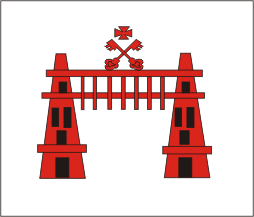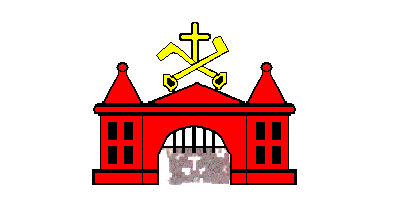 zachary harden
zachary harden
Keywords: riga | latvia |
Links: FOTW homepage | search | disclaimer and copyright | write us | mirrors

FOTW beschäftigt sich mit der Wissenschaft der Vexillologie (Flaggenkunde).
Alle auf dieser Website dargebotenen Abbildungen dienen ausschließlich der Informationsvermittlung im Sinne der Flaggenkunde.
Wir distanziert uns ausdrücklich von allen hierauf dargestellten Symbolen verfassungsfeindlicher Organisationen.
Last modified: 2023-06-03 by  zachary harden
zachary harden
Keywords: riga | latvia |
Links: FOTW homepage |
search |
disclaimer and copyright |
write us |
mirrors
See also:

image by Gvido Pētersons, 16 June 1999
In 1270 Riga get "Hamburg rights" and flag with
white cross in middle (background undefined). In XIII-XIV cc Riga
have merchant flag - black with white cross.
Gvido Pētersons , 16 June 1999

image by Phil Nelson, 20 Febuary 2000
Znamierowski: The World Encyclopedia of Flags [zna00], shows several interesting
flags of the port cities of northern Europe. These are
derived from gonfalons, originally red in color. The flags,
in a banner form, were flown from the stern of the vessels, the
mast carrying the gonfalon of the colors. Here is the flag of
Riga, in the 14th century .
Phil Nelson, 20 Febuary 2000

image by Gvido Pētersons, 16 June 1999
After 1582, the merchant flag of Riga was white with red Coat
of Arms.
Gvido Pētersons, 16 June 1999
The cover of [sie63] shows
what the book describes as approximately a quarter of a
flagchart, one of many to roll of the, mostly Dutch, presses for
the use of seafarers: "Tableau des Pavillons que la Plupart
des Nations arborent a` la Mer. Faitau de'po^t des cartes et
plans de la marine pour le service des vaisseaux du Roy par ordre
de M. de Machault, Garde de se'aux de France. Par le Sr. Bellin
Inge'nieur de la marine. 1756." [beL56]
On the 2nd row from the bottom there is "Pavillon de Riga en
Livonie" - A white flag with a town-gate in red, detailed in
black, wit two gold tips. Above the building two crossed keys in
grey, bits upward and outward, about as wide as the central gate
building; above those, nearly touching, a small latin cross in
grey, not quite half as high as the keys are long. Standing (or
sitting) in the gateway an undeterminable creature white,
outlined in black. [Half the creature's height is face with eyes,
so either it's a head-feet, standing, or its a monster
sitting/laying under the gate with little more than its head
visible, the latter seems more plausbile.] The town-gate is the
usual image: Two towers, with 5 windows each placed 2,1,2,
slightly wider feet and eaves, steeples slightly sharper than
equilateral (in this case with golden tips). Wider central
building with in the upper half a window on either side, reaching
nearly as high as the eaves of the towers, with on top of that a
lightly overhanging obtuse gable. The gate as wide as the central
building, except for the stones of the arc, which makes not quite
as wide as the towers, and half as high as the building, arc from
the ground up and completely open, with the background showing
inside it merging with the background below it.
Peter Hans van den Muijzenberg, 4 January 2001
At J.W Norie - J.S. Hobbs: Flaggen aller seefahrenden
Nationen, 1971[ nor71] (original
print 1848):
99 Riga - A bit likethe above, but the charge is closer to the
hoist, there is no monster, the gate is open at the foot, as in
the text below the image, and the person colouring in the image
apparently thought keys and cross were part of the building and
coloured upward to make it all the same red blur.
Peter Hans van den Muijzenberg, 12 November 2001

image by Gvido Pētersons, 16 June 1999
In middle of XVII century, Riga had Swedish merchant flag with
CoA on red field.
Gvido Pētersons, 16 June 1999
At J.W Norie - J.S. Hobbs: Flaggen aller seefahrenden
Nationen, 1971[ nor71] (original
print 1848):
100 Riga - As above, except the cross is centered, there's no
cross in the arms and the blue is lighter.
Peter Hans van den Muijzenberg, 12 November 2001

image by Gvido Pētersons, 16 June 1999
In 1673 a new flag for Riga was approved: blue and white. It
was existed untill the middle of XIX C. and between 1920-1940
Gvido Pētersons, 16 June 1999

image by Jaume Ollé, 30 April 2003
No. 513 - Riga.
Source: [stb62]
Jaume Ollé, 30 April 2003

image by Jaume Ollé, 5 September 2003
No. 938 - Riga.
Source: [stb62]
Jaume Ollé, 5 September 2003

image by Jaume Ollé, 5 September 2003
No. 939 - Riga.
Source: [stb62]
Jaume Ollé, 5 September 2003

image by Jaume Ollé, 16 November 2003
Addition No. 435a - Riga.
Source: [stb62]
Jaume Ollé, 16 November 2003

image by Klaus-Michael Schneider, 16 October 2007
It is a plain white flag with a red gate.
Source : Poster entitled: "Die geschichtliche Entwicklung
der als deutsche Nationalflaggen auf See gefahrenen und von den
seefahrenden Nationen anerkannten deutschen Kriegs- und
Handelsflaggen" (The historical evolution of those German
national flags used on ships and recognized as German war flags
or merchant flags by the naval nations), edited by Deutsches
Schifffahrtsmuseum Bremerhaven, 1981, based on an original
version of Kapitan zur See a.D. Karl Schultz, all flags on the
poster are painted by E. Paschke.
Klaus-Michael Schneider, 16 October 2007
![[Riga since 1295]](../images/l/lv_rg12.gif) image by Klaus-Michael Schneider, 28 Nov 2005
image by Klaus-Michael Schneider, 28 Nov 2005
Riga since 1295: A plain black pennant with a single white
cross shifted to the hoist.
Source : Poster entitled: "Die geschichtliche Entwicklung
der als deutsche Nationalflaggen auf See gefahrenen und von den
seefahrenden Nationen anerkannten deutschen Kriegs- und
Handelsflaggen" (The historical evolution of those German
national flags used on ships and recognized as German war flags
or merchant flags by the naval nations), edited by Deutsches
Schifffahrtsmuseum Bremerhaven, 1981, based on an original
version of Kapitan zur See a.D. Karl Schultz, all flags on the
poster are painted by E. Paschke.
Klaus-Michael Schneider, 28 November 2005

image by Gvido Pētersons, 16 June 1999
From the middle of XIX century untill 1917 Riga had a
blue-red-white tricolour.
Gvido Pētersons, 16 June 1999

obverse
image by Antonio Martins and Antonio Gutiérrez,
6 September 2003

reverse
image by Antonio Martins and Antonio Gutiérrez,
6 September 2003
Riga flag under soviet
occupation till 1988.
Source: Enciklopedija RIGA 1988 in latvian.
Guy Babonneau, 12 March 2001
The said flag is rather a pendon, fixed to a wodden pole
(suited for carrying, apparently) with five ribbons and with a
golden fringe in the fly; height to width ratio is approx. 11:16;
there is a golden vertical criss-cross ornament along the fly on
both sides.
The reverse says indeed «Ri_gas pilse_ta / gorod Riga», which
means "city of Riga" in Latvian ("_" is a
macron over the preceding letter) and Russian (in cyrillic
letters, of course) in golden fantasy capitals, bellow a
depiction of the lavtian RSS emblem; the obverse says «VISU
ZEMJU PROLETA_RIES~I, SAVIENOJIETIES!», which means
"Workers of the Wold, unite!" in Latvian (with macron
and hacheck) above the black and white iconic image of Lenin's
face (incl. golden laurel branch).
Now, I have some doubts about this being the
pre-1988 flag of Riga: Note that this is a ceremonial banner,
suited for indoor or parade display; that the only reference to
the city is on the reverse (the "not-main" side); and
that there is a vacant space at the bottom of the obverse - a
space suitable for additions like «Production prize 1976 awarded
to the glorious 12th brigade of Riga Saw Mill in the name of V.
I. Lysenko» or something like that.
Moreover, all known soviet territorial flags other than SSR's and
ASSR's have been always unofficial - I think that this one is not
even that.
I remark also that this flag is apparent scarlat (alyi~)
and not purpure (krapovyi~), comparing the background
with the relevant parts of the emblem - it was just photographed
too darkly.
Note also that the emble is depicted in a <su-lv.html#coa>
third variant: The star is plain yellow and only slightly dense
(or nothing at all), and the sun is solid yellow, not
transparent.
Antonio Martins, 6 September 2003
Hosted by: Fanshop-Online.de und Handy-Shop.de
Tipp: Apple iPhone 15 im Shop